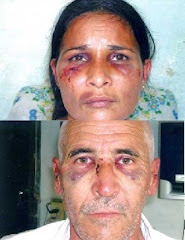He is eight years old and enormously confused. This morning his mother
put 25 centavos in his hand, telling him, "Here are five pesos." He
looked at the shiny surface with the shield of the Republic on one side
and on the back the tall thin tower of the city of Trinidad. Although
born in an economically schizophrenic country, he is still not used to
the switch from Cuban pesos to their convertible relatives. At school
the teacher has never talked about the issue, but to explain it would
take an entire course over a whole semester. Nor do they explain much
at home, as if the adults think it is normal that they mix two kinds of
money in their wallets.
In Cuba there are four kinds of markets and two different types of money
to pay for things in them. Every morning the housewives detail in their
heads – with a minimum of fuss – a plan for which currency they will use
to buy what, in which places. It's an arithmetical operation that takes
a few seconds, fifteen years after the implementation of dollarization
and its subsequent "ghost," the convertible peso. The conversion is
done constantly and there are sellers who accept both the symbolic
tokens they pay our wages in, and the others with a value 24 times
greater. For a pineapple we can pay as much as 10 pesos in national
money – a day's wages – or about fifty centavos in the money commonly
called "chavitos." Some tourists are not aware of such complexities and
acquire the queen of fruits for ten convertible pesos. That day, the
trader closes his stall quickly and goes home happy for the mistake.
My son's generation does not understand what it's like to live with a
single currency. I think they have a special development in the area of
the brain that eventually accepts the absurd, in the neural connections
that handle the unacceptable. They perform currency conversions with
the ease of someone who has learned two languages since infancy and
alternates them with little difficulty. Except that the learning of
several languages is always enriching, but taking for normal the
financial duality is to accept that there are two possible lives. One
of them is flat and gray, like the national centavos, and the other –
which is forbidden in all its extension to a good part of the population
– seems full of colors and watermarks, like the style of the twenty
convertible peso bill.
Translator's Note:
Briefly, Cuba has two currencies. Moneda nacional (national money or
the Cuban peso) is the currency that wages are paid in and some goods
are sold in. The convertible pesos (CUC) is the currency tourists must
exchange their dollars, euros, or other currencies for. Many goods are
sold, even to Cubans, only in CUCs. One CUC is worth 24 Cuban pesos.
After the Revolution, possession of the U.S. dollar was outlawed in Cuba
until 1993, when it was permitted. The CUC replaced the U.S. dollar in
2004. The slang name for CUCs, "chavitos," is a play on Hugo Chavez's name.
Generation Y » Two Currencies and Four Markets (4 February 2010)
http://www.desdecuba.com/generationy/?p=1452

No comments:
Post a Comment